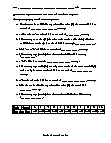Commutative, Associative, and Distributive Properties Worksheets
What are Commutative, Associative, Distributive Properties? Commutative, associative, and distributive properties are the three properties underpinning the fundamentals of algebra. Students are first introduced with these properties in broader terms in the early years. However, as the students learn advance concepts, the understanding of these properties become essential. Commutative Property - Commutative is derived from the word commute, which means to move around. As the name implies, the commutative property refers to moving the numbers around. The commutative rule states that if we move the numbers around, we will still get the same answer. The equation of commutative property of addition is written as: a + b = b + a. The equation of commutative property of multiplication is written as: a x b = b x a. Associative Property - The word associative is derived from the word 'associate' which means to 'group'. And as the name implies, associative property refers to associating or grouping number. The associative property also states that grouping and regrouping of numbers don't affect the result. The equation of associative property of addition is written as: (a + b) + c = a + (b + c) The equation of associative property of multiplication is written as: a x (b x c) = (a x b) x c Distributive Property - Distributive property states that multiplication distributes over addition. The equation of this property is written as: a x (b + c) = a x b + a x c.
-
Basic Lesson
Reviews each property and provides examples. Demonstrates the identification of properties. Identify which property is used in each computation.
View worksheet -
Independent Practice 1
Complete problems like: Addends can be added in any order without changing the sum. This is _________________ property. The answers can be found below.
View worksheet -
Independent Practice 2
This property says multiplying a sum by some number is the same as multiplying each term by that same number. What is it?
View worksheet -
Homework Worksheet
8 property questions for students to work on at home. Examples of each property are provided and explained.
View worksheet
Commutative Property
The commuting distance is the same in either direction, from home to work or work to home.
Associative Property- To associate with people is to group with them.
Distributive Property- To distribute something is to give it to everyone.






